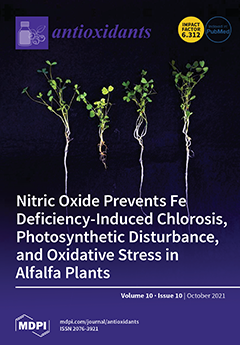The wastewater from the distillation of rose oils is discharged directly into the soil because it has a limited potential for future applications. The aim of the present study was to determine in vitro the chromatographic profile, redox-modulating capacity, and antineoplastic activity of wastewater obtained by distillation of essential oils from the Bulgarian
Rosa alba L.,
Rosa damascena Mill.,
Rosa gallica L., and
Rosa centifolia L. We applied UHPLC-HRMS for chromatographic analysis of rose wastewaters, studied their metal-chelating and Fe(III)-reducing ability, and performed MTT assay for the evaluation of cytotoxic potential against three tumorigenic (HEPG2—hepatocellular adenocarcinoma, A-375—malignant melanoma, A-431—non-melanoma epidermoid squamous skin carcinoma) and one non-tumorigenic human cell lines (HaCaT—immortalized keratinocytes). The median inhibitory concentrations (IC
50) were calculated with nonlinear modeling using the MAPLE
® platform. The potential of the wastewaters to induce apoptosis was also examined. Mono-, di-, and acylated glycosides of quercetin and kaempferol, ellagic acid and its derivatives as main chemical components, and gallic acid and its derivatives—such as catechin and epicatechin—were identified. The redox-modulating capacity of the samples (TPTZ test) showed that all four wastewaters exhibited the properties of excellent heavy metal cleaners, but did not exert very strong cytotoxic effects. The lowest IC
50 rate was provided in wastewater from
R. centifolia (34–35 µg/mL of gallic acid equivalents after a 72 h period for all cell lines). At 24 and 48 hours, the most resistant cell line was HEPG2, followed by HaCaT. After 72 h of exposure, the IC
50 values were similar for tumor and normal cells. Still,
R. damascena had a selectivity index over 2.0 regarding A-431 non-melanoma skin cancer cells, showing a good toxicological safety profile in addition to moderate activity—IC
50 of 35 µg/mL polyphenols. The obtained results related to wastewaters acquired after the distillation of essential oils from the Bulgarian
R. alba,
R. damascena,
R. gallica, and
R. centifolia direct our attention to further studies for in-depth elucidation of their application as detoxifying agents under oxidative damage conditions in other experimental datasets.
Full article






